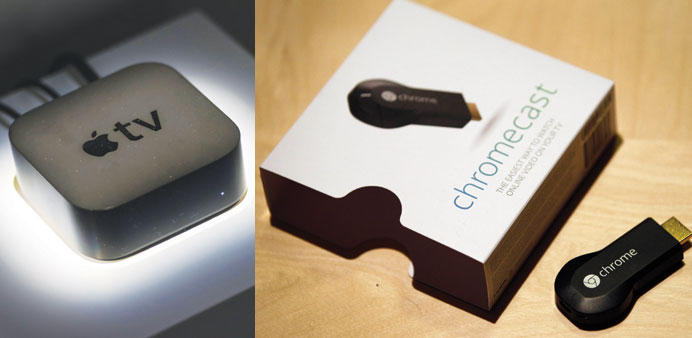Amazon.com has sent an e-mail to its marketplace sellers that it will stop selling Apple TV and Google’s Chromecast since those devices don’t “interact well” with Prime Video.
Bloomberg
San Francisco
Amazon.com will stop selling media-streaming devices from Google and Apple that aren’t easily compatible with its video service, the latest example of the company using its clout to promote products that fit with its own retailing strategy.
The Seattle-based Web retailer sent an e-mail to its marketplace sellers that it will stop selling the Apple TV and Google’s Chromecast since those devices don’t “interact well” with Prime Video. No new listings for the products will be allowed and posting of existing inventory will be removed October 29, Amazon said. Prime Video doesn’t run easily on its rival’s hardware.
Roku’s set-top device, Microsoft Corp’s Xbox and Sony Corp’s PlayStation, which work with Amazon’s video service, aren’t affected, it said. Amazon’s Fire TV stick, which plugs into an HDMI port to connect televisions with streaming services such as Netflix and Prime Video, is the company’s best-selling electronic device.
The move, coming just before the year-end holiday shopping season, shows how Amazon is willing to sacrifice sales of popular brand name products — Apple and Google have the best-selling media streaming devices generally — to bolster its own video-streaming service. Amazon has invested heavily in online content, including producing its own exclusive shows such as the award-winning transgender comedy Transparent, as a way to attract new Prime subscribers, who pay $99 a year for speedy shipping and access to video and other services.
Amazon’s strategy will likely hurt Google more than Apple, which has its own stores and direct access to customers. The move may also cost Amazon sales by diverting purchases of popular devices to competitors such as Best Buy Co.
“This has the potential to hurt Amazon as much as it does Apple and Google,” said Barbara Kraus, an analyst at Parks Associates. “As a retailer, I want to give people a reason to come to me. When I take out best-selling brands, I take away those reasons.”
Tom Neumayr, a spokesman for Apple, declined to comment. A Google representative also declined to comment.
Amazon, Apple, Google and Roku devices made up 86% of all media-streaming products sold to US households with broadband in 2014, according to an August report by Parks Associates. An estimated 86mn media-streaming devices will be sold globally in 2019, the research firm said.
Amazon supplanted Apple for the No 3 position in sales in 2014, Parks said. Roku led the market with 34% and Google was second with 23%, according to the report.
“Over the last three years, Prime Video has become an important part of Prime,” Amazon said in the e-mail, which was sent to sellers yesterday. “It’s important that the streaming media players we sell interact well with Prime Video in order to avoid customer confusion.”
The online retailer used a similar strategy last year in a protracted and dispute with New York-based Hachette Book Group regarding the sale of print and digital books. Amazon blocked pre-orders for some of Hachette’s books while the two sides haggled over prices. A coalition of authors accused Amazon of engaging in anti-competitive practices during the conflict.
Amazon’s decision to limit the sale of Google and Amazon streaming devices probably doesn’t rise to the level of an antitrust violation, because consumers will still have options for buying Apple and Google products at other places, according to Allen Grunes, a lawyer at Konkurrenz Group in Washington.
“Amazon probably wants to teach Apple and Google a lesson about not making their devices more compatible,” Grunes said.
“This is one way to do it and it’s not likely anticompetitive,”
Amazon’s decision to limit selection “sends the wrong signal to consumers,” and the company’s explanation that Prime Video doesn’t work well with its rivals’ products is “especially weak,” said Michael Pachter, an analyst at Wedbush Securities in Los Angeles.
“Fewer than 20% of Amazon customers are Prime members,” Pachter said. “What about the 80% who want an Apple TV to stream Netflix? I think that the excuse of avoiding customer confusion is a not-so-veiled attempt to favour Amazon first-party products over third-party products, and think it was a bad move.”

